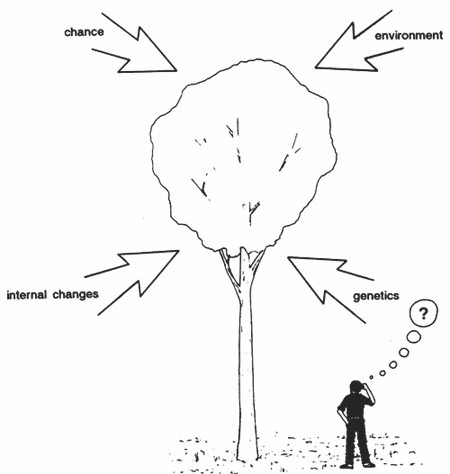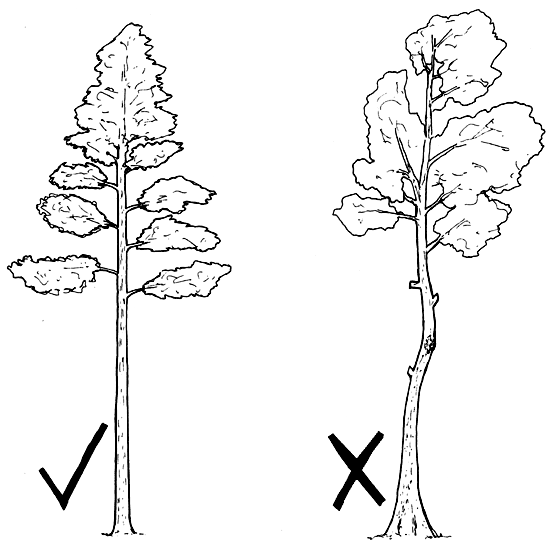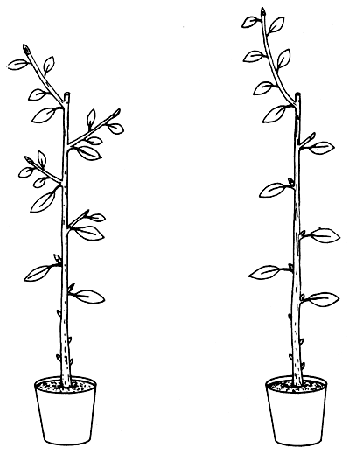Genetic Selection | A 10 |
- introduction |
What is meant by genetic selection of trees?
Selection means choosing particular trees with desirable features as your source of plants, in preference to other trees or unselected origins.
Isn't that easy?
No, because a tree will be like it is for a variety of reasons (A 3, A 6):

Only features influenced by (a) will be passed on, so genetic selection means learning how to choose trees so that desirable characters which are strongly inherited are favoured.
How much genetic improvement is possible?
A great deal. This is because most tree species:
Why hasn't more been done, then?
For four main reasons. Because:
It is more difficult still with tropical trees?
Yes, because they:
What approaches were overlooked?
The rooting of ‘juvenile’ shoots as cuttings, for instance.
Why did this happen?
Because the first forest geneticists concentrated on improvement through seed, instead of combining the two ways of producing planting stock.
Well, most trees are grown from seed, aren't they?
Yes, and a good start to tree improvement comes from:
However, further progress is generally by small steps that can take many years, and may sometimes fail to provide enough genetically improved seed.
But I thought vegetative methods were used for seed orchards.
Yes, but these are different techniques (Manual 2), involving:
What selection techniques are used when rooting cuttings?
They are simpler and quicker, for you can use the selected trees directly. Such systems have been used for decades for temperate-zone plantations of Populus, and over centuries for Cryptomeria. Using similar methods, tropical farmers grow chosen strains of cassava (manioc), bananas, yams, etc. (A 3). Besides being simpler, several stages can be done at once:
Why has less effort been put into tropical trees?
Because:
But everyone knows that tropical trees are very important!
Yes, we are learning fast that they produce hundreds of things that people need; provide the conditions needed for agriculture; and protect the local soil, the regional climate and the world's temperature (A 1).
A 11 | |
- clones |
What is a clone?
All the vegetatively produced plants arising from a single tree of seedling origin.
What's so special about such plants?
They are all very similar to each other, and can look almost like a set of ‘photocopies’. However, like any tree, their growth is also affected by environment, competition and chance damage.
Why are they so similar?
Because, although they may grow in different environments, they have exactly the same genetic make-up, like identical twins. [Note: very occasionally, a small but permanent genetic change can occur in a member of a clone, and this may be passed on in cuttings taken from it.]
How different is one clone from others in the same species?
It can be completely different. For instance, some clones grow into tall, straight trees, while others are crooked and forked. In Triplochiton scleroxylon, certain clones can even be bushy, with several main stems or heavy branches.

Will I get greater yields of produce by planting good clones?
When clones have been selected for early, regular, heavy fruit production, as has been done, for instance, by grafting Treculia africana in Nigeria, the clones can be expected to out-produce trees raised from seed, just like selected rubber, oil-palm or mango clones.
Is the same true for yields of wood?
If clones have been selected for stem straightness and favourable branching habit, they are likely
to show a considerable improvement in these characters over trees raised from seed.
Greater height and diameter growth can also be expected, although these are more strongly
influenced by environment and competition.
Should I plant a single, highly productive clone?
No! A mixture of 10–30 good clones is recommended for tree crops that take many years or decades to mature. Stands in which every tree had the same inherent characters would be too risky, for that clone might prove susceptible to drought, pests or disease, or be found to have other unwanted features.
Doesn't 10–30 clones still reduce genetic variation too much?
Only for seed stands, which will provide seeds for later planting, where greater genetic diversity is important to avoid inbreeding; and for gene banks, which are storehouses of variability for future tree improvement (Manual 2).
How do I know that the clones will be good ones?
Everyone recognises the (genetic) differences between clones of plantain, banana, mango, etc. Clones of trees have only recently been selected, so it will take longer to get to know them. However, forest scientists have shown that some ‘domesticated’ Eucalyptus and Triplochiton clones have the potential to outgrow and outproduce by far the ‘wild’, seedling trees.
Will we have to wait long to get supplies of these new clones?
They will need to be multiplied and tested first (Manual 4). However, the waiting time will be much less than with tree improvement by seed, because:
Will all the clones come from the most successful provenance?
Not necessarily. Because clonal selection is more precise, good clones can also be found within provenances that, on average, were not so successful. This means that a well-chosen clonal mix can contain trees that are much less closely related than those in many seedling stands.
What else is important?
Not losing the clones, or getting them muddled up.
How can I safeguard my clones?
A 12 | |
- choosing good trees |
Is it difficult to select trees?
Not once you have “got your eye in” with a particular species.
Remember that the desired features will be different when trees are being grown primarily for
fruit, latex, shade or ground cover, rather than main stem wood.
What size of tree should I select?
Trees from about 3–30 m tall are most suitable (see A 13 for selection tests for small trees).
Is it easier in plantations?
Yes, much simpler, because one is choosing between trees of about the same age. However, natural trees can be included if they occur.
How do I know the tree's good points will be passed on?
Only the inherited features will be passed on (A 3, A 10). Fortunately, however, several important features are strongly inherited, so that there is a good chance that selection will be effective.
What are they?
For example, stem form, branching habit, wood structure, tolerance to disease and early flowering are usually highly inherited.
How do I select for good stem form?
Should I score all species the same?
No, because the natural growth habit is much better in some species than in others. For example, Terminalia trees are often straight, so your selection standard should be high. On the other hand, Lovoa trichilioides is often crooked and forked, and Gmelina heavy-branched (or sometimes with multiple stems), so here your standard may have to be less strict.

What about branching habit?
Score this at the same time as selecting for stem form, and look for:
How about the size of the tree?
Yes, it is worth recording the diameter at breast height, and perhaps the height. However, as size depends so much on patches of different soils, competition and chance, give less weight to it.
But isn't measurement more reliable than a score?
One can easily check that a measurement is accurate, whereas a score always depends partly on the opinions of those giving it. However, the important features like stem form and branching habit are hard to measure, but easy to see and agree on as an approximate score.
How can wood quality be assessed?
This cannot easily be done in the field, although it might be possible to send numbered wood specimens for testing when selected trees are felled to stimulate coppice shoots for propagation as cuttings (A 21).
Can disease resistance be selected for?
If disease is present in the stand, or there are signs of previous damage, then healthy, undamaged trees should be chosen. Otherwise, testing for tolerance to disease is best done as a clonal test at a later stage (Manual 4).
What about early flowering?
In trees giving useful fruits, select for:
Fruit set is less likely to be strongly inherited.
In trees grown for main stem wood, a – c may be undesirable (Manual 2).
Isn't it a pity to fell the best trees?
In one way, it is. However, until research workers find reliable ways of stimulating coppice
shoots on intact trees, this method gives us the best chance of ‘re-growing’ selected trees in
large numbers. Coppicing lets us regain the juvenile stage, start new clones and make many
trees of each.
After further testing, some of these clones may turn out to have outstanding combinations of
desirable, inherited features that will greatly improve the quality of later plantings.
Does it matter where the trees are selected?
It is certainly true that easy access to the coppiced stumps, and nearness to the propagation nursery are both useful. However, it is much more important to search for good trees, even in remote areas. This is often where trees with favourable characteristics still exist, and you also need to include genes from different sites and parts of the country, to sample the available range of genetic variation.
A 13 | |
- tests for small trees |
What are these selection tests for?
To find out which are the better and which the less good trees.
But surely you can't tell which trees are good till later on!
Some features (such as branching habit) often show up during the first few years; others (like wood structure) can only be found out later on.
How can the tests help?
By showing at an even earlier stage, while the plants are still in the nursery, what the inherent branching habit is going to be like, for example.
How is this done?
In Cedrela odorata and Triplochiton scleroxylon, for instance, the tip of the shoot is removed when nursery plants are about 20 – 30 cm tall.

Trees which will be branchy later on produce many branches in response; whereas those which will put more into a single main stem produce only a few, one of which quickly replaces the lost leading shoot.
Do growing conditions matter for the test?
Yes, it is important that all the trees:
How soon can I tell which are the best?
In Triplochiton, the outgrowth of branches reaches a peak in 2 weeks. Strongly dominant replacement leaders may form during weeks 3 – 6.
How can I use the selected plants?
If the test is done on a batch of:
Can I use this test for other trees?
Research is going on to develop a test suitable for different species.
What else can be tested for when the plants are still small?
Sometimes small trees can be inoculated with a disease, in order to find out which of them are badly damaged or killed, and which are tolerant to it and little affected. Clones can then be started from those best able to cope with the disease.